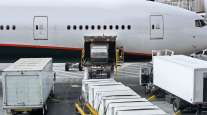Staff Reporter
Spot Rate Bottom Unclear Amid Capacity, Demand Mix

[Stay on top of transportation news: Get TTNews in your inbox.]
Excess capacity in the spot market amid weakening demand has raised uncertainty over whether rates have actually hit bottom.
“We’ve still got a lot more capacity in the spot market than we do loads,” said Dean Croke, principal analyst at DAT Freight and Analytics. “It’s exacerbated more by the fact that demand is softer in the first half of this year because of all those macroeconomic things that are going on. Imports are way down, housing industry has grounded to a halt for the most part, new home starts are way down, consumers aren’t spending as much.”
Arrive Logistics reported March 20 that downward pressure on rates persists as truckload demand normalizes closer to where it was before the coronavirus pandemic. The report also noted that the surplus capacity accumulated over the last few years should drive a prolonged period of spot market equilibrium and deflationary contract rates.
“We have seen spot rates decline slow,” said David Spencer, vice president of market intelligence at Arrive. “Our forecast is calling for a bottoming out or a low point from a cycle perspective, when you exclude fuel, here in April. That’s not to say we’re expecting spot rates to start to increase from there. But we’d see it go up and down with normal seasonality.”
The report also showed the national average spot rate peaked at $2.72 per mile in January 2022. But it quickly began collapsing before eventually hitting $1.64 in November 2022. It has hovered around there since while slowly becoming even flatter.
“We think there’s only really so far down spot rates can go before you start seeing that reaction from carriers,” Spencer said. “That helps create a floor. That can drive a lot of behavior on the carrier side that can create some resistance to further downward movements. But the big variable here that we’re watching really is the demand side.”
TD Cowen noted in a report March 30 that a firm consensus on a spot rate bottom remains elusive among private carriers. The report showed that 30% of those surveyed suggested that spot rates have already bottomed while 23% called for a bottom in the second quarter of 2023. It also showed downward pressure has persisted on contract rates through bid season.

Seidl
“Markets like this can’t persist for that long in terms of the direction of pricing,” Cowen analyst Jason Seidl said. “So, are we at the bottom? I’m not so sure it’s the bottom just yet, but we’re probably getting close.”
Seidl noted the commentary is similar to the prior quarter when some people thought spot rates already hit bottom. He pointed out that now in retrospect it’s clear they were wrong. But the decline has slowed significantly.
“When you look back historically, spot rates always precede contracts,” Seidl said. “Because spot is ever-changing by the hour and by the lane. And when you see big directional moves over a long period of time, typically what happens is contracts will follow that move next. But you’ll never get the same magnitude of moves in the contract that you had in the spot.”
Croke pointed out that economic factors like a troubled housing market and produce season have suppressed freight demand. He noted that nearly every tonnage index report is indicating demand should remain relatively flat this year. But he does expect some minor improvements to start midyear.
Want more news? Listen to today's daily briefing above or go here for more info
“We are working on the basis that demand for things truckers haul will be flat this year,” Croke said. “The first half is going to be lower and the second half will be higher. But if you draw a line across the year, it’d be flat.” Croke noted that it also depends on the equipment type. He believes dry van and refrigerated spot rates are still searching for the bottom of the market. The spot rate decline for those two types has slowed the last couple of months at about a couple of cents per week. But flatbed has been trending in the opposite direction.
“You’ve had now six months at basically the same levels, rates have continued to drop by a couple of pennies over that six-month period,” Brent Hutto, chief relationship officer at Truckstop, said. “It’s begun to stabilize out at the bottom of the economic curve. Not like rates are so low they’re unprofitable.”
Hutto noted load-posting volumes and spot rates are still above the historical average. Truckstop data shows that the average spot rate during the five-year span before the pandemic was between $2 and $2.20 per mile. The spot market the last three weeks has been $2.48 per mile. But that doesn’t mean carriers can handle rates going lower given the different economic conditions.
“We’ve had three weeks of the exact same rates overall in the market,” Hutto said. “It gives an indicator that we may sort of be at the bottom of that curve in the cycle.”




